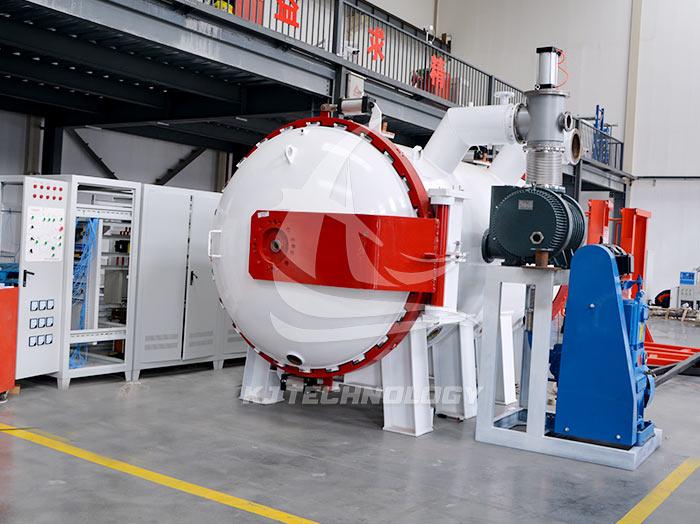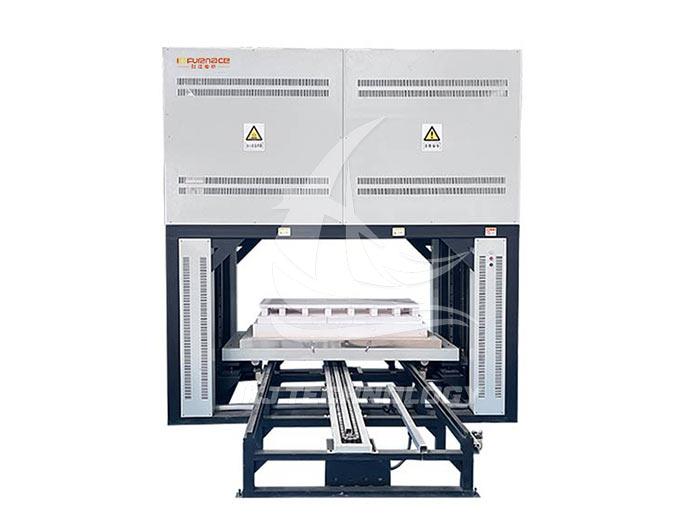Precautions for using high vacuum and high temperature brazing electric furnace
 08-26-2025 Author: KJ technology
08-26-2025 Author: KJ technology
As a precision heat treatment equipment, the use of high vacuum and high temperature brazing electric furnaces involves high temperature, high pressure, vacuum environment, and complex electrical systems. Improper operation may cause equipment damage, safety accidents, or process failures. The following are key precautions during use:
1. Preparation before operation
environment check
Ensure that there are no flammable or explosive materials around the equipment, good ventilation, and avoid the accumulation of high-temperature gases or dust.
Check if the equipment grounding is reliable to prevent the risk of electrical leakage.
Equipment status confirmation
Check whether the oil level of the vacuum system (such as mechanical pump, molecular pump) is normal and there is no leakage.
Confirm that the cooling water system is unobstructed, the water temperature and flow rate meet the requirements (usually below 30 ℃), and avoid damage to the heating elements due to insufficient cooling.
Check whether the heating element (such as graphite heating tube) is intact, without fracture or oxidation.
Verify the effective calibration of sensors such as thermocouples and vacuum gauges to ensure accurate temperature and vacuum measurements.
Workpiece preparation
Clean the surface of the workpiece, remove impurities such as oil stains and oxides, and avoid contaminating the furnace chamber or affecting the quality of brazing.
Reasonably place the workpiece to avoid blocking the heating element or interfering with the operation of the vacuum system.
2. Operation process specification
Vacuum pumping stage
Sequential operation: First, start the mechanical pump to pre pump to low vacuum (about 10 ⁻¹ Pa), then start the molecular pump to pump to high vacuum (usually below 10 ⁻¹ Pa).
Leakage inspection: Observe the change in vacuum degree during the vacuuming process. If the target value cannot be reached for a long time, stop the machine for leak detection (helium mass spectrometer leak detector can be used).
Avoid pollution: Before vacuuming, ensure that the furnace door is well sealed to prevent external gases or impurities from entering.
heating phase
Segmented heating: Set the heating curve according to the process requirements to avoid rapid heating that may cause excessive thermal stress on the workpiece or damage to the furnace body. For example, first raise the temperature at a lower rate to 300 ℃, hold for a period of time, and then continue to raise the temperature.
Power control: Adjust the heating power according to the size of the furnace cavity and the material of the workpiece to prevent local overheating or insufficient power.
Temperature monitoring: Real time observation of temperature display values and comparison with actual measurement values of thermocouples to ensure accurate temperature control.
Insulation and cooling stage
Insulation time: Strictly control the insulation time according to the process requirements to ensure that the brazing material is fully melted and the gaps are filled.
Cooling method: Choose the appropriate cooling method based on the material characteristics (such as furnace cooling, gas cooling, or oil cooling) to avoid cracking or deformation of the workpiece caused by rapid cooling.
Vacuum Maintenance: If cooling is required in a vacuum environment, the vacuum system must be maintained in operation until the temperature drops to a safe range.
3. Safety protection measures
personal protection
Operators need to wear protective goggles, insulated gloves, dust masks, etc. to avoid high temperature radiation, splashes, or dust injuries.
Do not touch the furnace body, heating elements, or vacuum pipelines during equipment operation to prevent burns.
Equipment safety
Install safety devices such as overload protection, leakage protection, and over temperature alarm, and regularly test their effectiveness.
Install heat shielding devices inside the furnace cavity to reduce the damage of heat radiation to the furnace structure.
Avoid sudden power outages during the operation of the vacuum system to prevent damage to the molecular pump due to oil reflux.
emergency response
Develop emergency plans and clarify the procedures for handling unexpected situations such as fires, electrical leaks, and vacuum leaks.
Equip emergency supplies such as fire extinguishers and first aid kits, and ensure that operators are familiar with the usage methods.
4. Maintenance and upkeep
Daily cleaning
Clean the residue inside the furnace chamber after each use to avoid corrosion of the furnace body or contamination of subsequent workpieces.
Regularly clean the filter screen of the vacuum pump to prevent dust from clogging and affecting the pumping efficiency.
regular maintenance
Vacuum system: Check the oil quality of the vacuum pump every 3-6 months and replace it if necessary; Inspect the vacuum valve and seals once a year.
Heating system: Check if the heating element connections are loose and if the oxide layer is too thick every six months (it needs to be cleaned or replaced in a timely manner).
Electrical system: Insulation resistance, grounding resistance and other parameters are tested annually by professionals to ensure electrical safety.
Lubrication and replacement
Regularly lubricate moving parts such as furnace door lifting mechanisms and vacuum pump rotors to reduce wear and tear.
Replace vulnerable parts (such as sealing rings, thermocouples, vacuum gauge gauges, etc.) according to the equipment manual requirements.
5. Process parameter control
Vacuum degree selection
Determine the vacuum requirement based on the characteristics of the solder material. For example, active brazing materials such as Ag Cu Ti require a higher vacuum degree (below 10 ⁻⁴ Pa) to prevent oxidation.
Avoid prolonged heating under low vacuum to prevent surface oxidation of the workpiece or volatilization of the brazing material.
temperature uniformity
By optimizing the layout of heating elements or adding thermal circulation fans, the temperature uniformity inside the furnace can be improved (usually controlled within ± 5 ℃).
For large workpieces or complex structures, segmented heating or preheating processes can be used.
atmosphere control
If protective gases (such as Ar, N ₂) need to be filled, the gas purity (≥ 99.999%) and flow rate should be controlled to avoid contaminating the workpiece or affecting the vacuum degree.
Before inflating, it is necessary to break the vacuum to a safe pressure to prevent damage to the furnace body due to pressure differences.








